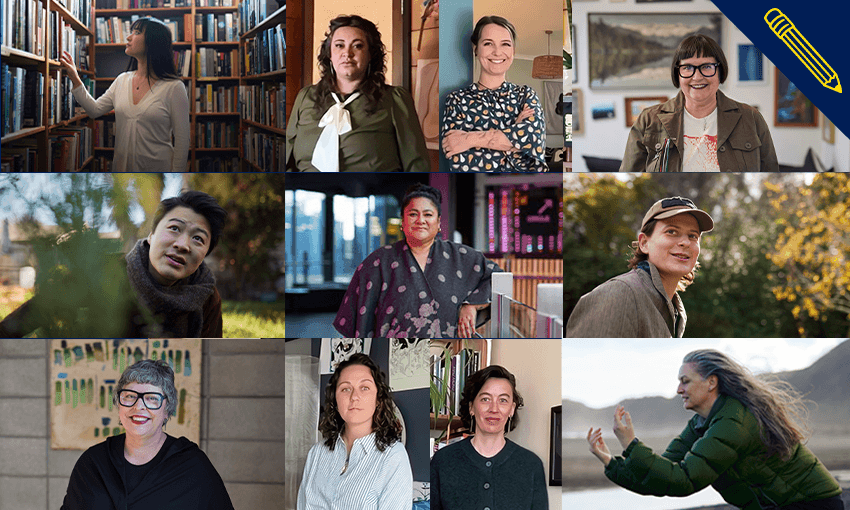Sam Brooks reflects on lessons learned from the latest series of Art Work, a collection of interviews with prominent artists about their creative processes and working lives.
For this second series of Art Work, we interviewed 11 artists across the motu. They included the Golden Lion winners at this year’s Venice Biennale, a recent ONZM honoree, an Ockham Book Award winner, one of our most respected choreographers, and several multidisciplinary artists – all shared stories of the everyday joys and challenges of making art in Aotearoa. They gave us an insight into their current creative processes, and highlighted the things that might make it easier for them to continue making art into the future.
Those suggested pathways included introducing a universal basic income, rethinking the art world’s reliance on private philanthropy, more opportunities for wānanga and connections with communities, and a shift in the way we value certain artforms above others. Through all the interviews, two words kept cropping up: time and money.
These concepts are intertwined. With more support and funding, artists will have time to make their art. With more time to make their art, artists will be able to not just create art in the first place, but make work that is richer and deeper. And who ultimately benefits? The audiences.
In a recent column for The Post, outgoing Creative New Zealand CEO Stephen Wainwright wrote about the awkward gap between audiences who benefit from the arts and the artists who often struggle to make that art. “While New Zealanders enjoy a sense of wellbeing from the arts, artists are simply not earning enough to sustain themselves, let alone their careers,” he said. “In New Zealand we do not have the same guardrails as in other places that help gig economy workers to assemble a viable living.
“If we all want to continue enjoying the myriad benefits the arts offer, we need to think about strategic and structural changes that will ensure the makers of our creative culture benefit, fairly, too.”
The statistics give us an extremely clear picture of how important art is to New Zealanders. Back in April, Creative New Zealand released the most recent “New Zealanders and the Arts Ko Aotearoa me ōna Toi” report, which measured New Zealand audiences’ appreciation of the arts. Of those who responded, 78% said they engaged with the arts, while 72% reported that they attended arts events.
We know that audiences value the art that our artists make. However, that appreciation isn’t necessarily making a difference to artists’ day-to-day lives. For many of the artists we profiled for this series, the value is in the work. This is noble, but it isn’t enough. Support and structure needs to be in place as well.
The equation is simple. For audiences to enjoy art, art needs to be made. For art to be made, artists need to be supported. We’ve heard in this series of Art Work what support these artists need. The solutions are there.
But how does the change happen?
Since the conclusion of the last Art Work series, the state of the arts sector has changed. This time last year we were heading into an election where only three parties had visible arts strategies. Of these, only one – Act – ended up in government. The question wasn’t “Will this policy be adopted?” – it was “What policy is there to even adopt?”
Now there is a new government in charge and cuts occurring across almost every public service, including the arts. Despite this, there is a light in the tunnel. Last month, Paul Goldsmith, the minister for arts, culture and heritage, said the government would release a draft form of its in-progress national art strategy, the first of its kind in Aotearoa.
The government will be seeking artists’ and audience’s thoughts and reflections on the strategy, which is expected to be released before the end of the year. The details are unclear, but even a small step in the right direction is better than inaction, especially if artists can help guide where the pathway is being laid.
This strategy has been a long time coming, and similar initiatives across the world are leading to meaningful change for both artists and audiences. Australia recently instituted its own national arts strategy, Revive, which runs from this year through to 2028, and is intended to revitalise that country’s arts sector. Further afield, the UK’s Fabian Society recently released a bold manifesto for arts policy, highlighting the essential role the arts have to play in the new Labour government’s mission of national renewal.
Back home, artists and their advocates are continuing to push the conversation forward. The recently established Artist Resale Royalty scheme, which guarantees income to visual artists when their art is resold, grew out of tireless advocacy for such a scheme from within the sector. Arts Action Now! remains a core platform for the arts community to mobilise around on the issues that matter to them. It’s not all good news, of course. Many in the community are still mourning the unceremonious end of the Creative in Schools programme, which funded schools and kura to partner with professional artists to share their knowledge and creative practice with students.
Artists will always advocate for the arts – the activist brain is embedded in many practitioners; it’s second nature to them. Arts organisations will do the same, for themselves and on behalf of others. Their sustainability, and their survival, relies on it. The crucial piece in the puzzle remains the audiences.
Statistics can only tell so much of a story. For those in power to really understand that the arts matter to New Zealanders, they need to hear our stories. Tell them about the art you enjoy. Tell them how it makes you feel. Tell them how it has affected your life. Tell them it is important. Tell them it is vital. Tell them it is essential.
We know that art is work. The job now is to show how much it matters.

